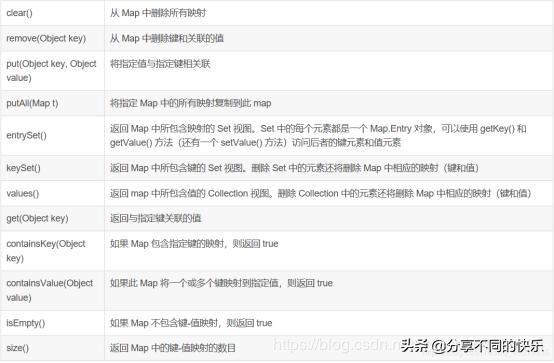1:Map(掌握)
(1)将键映射到值的对象。一个映射不能包含重复的键;每个键最多只能映射到一个值。
(2)Map和Collection的区别?
(3)Map接口功能概述

1、添加:
1、V put(K key, V value) (可以相同的key值,但是添加的value值会覆
盖前面的,返回值是前一个,如果没有就返回null)
2、putAll(Map<? extends K,? extends V> m) 从指定映射中将所有映射关
系复制到此映射中(可选操作)。
2、删除
1、remove() 删除关联对象,指定key对象
2、clear() 清空集合对象
3、获取
1:value get(key); 可以用于判断键是否存在的情况。当指定的键不存在的时候,返
回的是null。
3、判断:
1、boolean isEmpty() 长度为0返回true否则false
2、boolean containsKey(Object key) 判断集合中是否包含指定的key
3、boolean containsValue(Object value) 判断集合中是否包含指定的value
4、长度:
Int size()
(4)Map集合的遍历
A:键找值
a:获取所有键的集合
b:遍历键的集合,得到每一个键
c:根据键到集合中去找值
B:键值对对象找键和值
a:获取所有的键值对对象的集合
b:遍历键值对对象的集合,获取每一个键值对对象
c:根据键值对对象去获取键和值
代码体现:
Map<String,String> hm = new HashMap<String,String>();
hm.put(“it002″,”hello”);
hm.put(“it003″,”world”);
hm.put(“it001″,”java”);
//方式1 键找值
Set<String> set = hm.keySet();
for(String key : set) {
String value = hm.get(key);
System.out.println(key+”—“+value);
}
//方式2 键值对对象找键和值
Set<Map.Entry<String,String>> set2 = hm.entrySet();
for(Map.Entry<String,String> me : set2) {
String key = me.getKey();
String value = me.getValue();
System.out.println(key+”—“+value);
}
(5)HashMap集合的练习
public class Student {
private String name;
private int age;
public Student() {
super();
}
public Student(String name, int age) {
super();
this.name = name;
this.age = age;
}
public String getName() {
return name;
}
public void setName(String name) {
this.name = name;
}
public int getAge() {
return age;
}
public void setAge(int age) {
this.age = age;
}
@Override
public int hashCode() {
final int prime = 31;
int result = 1;
result = prime * result + age;
result = prime * result + ((name == null) ? 0 : name.hashCode());
return result;
}
@Override
public boolean equals(Object obj) {
if (this == obj)
return true;
if (obj == null)
return false;
if (getClass() != obj.getClass())
return false;
Student other = (Student) obj;
if (age != other.age)
return false;
if (name == null) {
if (other.name != null)
return false;
} else if (!name.equals(other.name))
return false;
return true;
}
}
- A:HashMap<String,String>
import java.util.HashMap;
import java.util.Set;
/*
* HashMap:是基于哈希表的Map接口实现。
* 哈希表的作用是用来保证键的唯一性的。
*
* HashMap<String,String>
* 键:String
* 值:String
*/
public class HashMapDemo {
public static void main(String[] args) {
// 创建集合对象
HashMap<String, String> hm = new HashMap<String, String>();
// 创建元素并添加元素
// String key1 = “it001”;
// String value1 = “马云”;
// hm.put(key1, value1);
hm.put(“it001”, “马云”);
hm.put(“it003”, “马化腾”);
hm.put(“it004”, “乔布斯”);
hm.put(“it005”, “张朝阳”);
hm.put(“it002”, “裘伯君”); // wps
hm.put(“it001”, “比尔盖茨”);
// 遍历
Set<String> set = hm.keySet();
for (String key : set) {
String value = hm.get(key);
System.out.println(key + “—” + value);
}
}
}
- B:HashMap<Integer,String>
import java.util.HashMap;
import java.util.Set;
/*
* HashMap<Integer,String>
* 键:Integer
* 值:String
*/
public class HashMapDemo2 {
public static void main(String[] args) {
// 创建集合对象
HashMap<Integer, String> hm = new HashMap<Integer, String>();
// 创建元素并添加元素
// Integer i = new Integer(27);
// Integer i = 27;
// String s = “林青霞”;
// hm.put(i, s);
hm.put(27, “林青霞”);
hm.put(30, “风清扬”);
hm.put(28, “刘意”);
hm.put(29, “林青霞”);
// 下面的写法是八进制,但是不能出现8以上的单个数据
// hm.put(003, “hello”);
// hm.put(006, “hello”);
// hm.put(007, “hello”);
// hm.put(008, “hello”);
// 遍历
Set<Integer> set = hm.keySet();
for (Integer key : set) {
String value = hm.get(key);
System.out.println(key + “—” + value);
}
// 下面这种方式仅仅是集合的元素的字符串表示
// System.out.println(“hm:” + hm);
}
}
- C:HashMap<String,Student>
import java.util.HashMap;
import java.util.Set;
/*
* HashMap<String,Student>
* 键:String学号
* 值:Student 学生对象
*/
public class HashMapDemo3 {
public static void main(String[] args) {
// 创建集合对象
HashMap<String, Student> hm = new HashMap<String, Student>();
// 创建学生对象
Student s1 = new Student(“周星驰”, 58);
Student s2 = new Student(“刘德华”, 55);
Student s3 = new Student(“梁朝伟”, 54);
Student s4 = new Student(“刘嘉玲”, 50);
// 添加元素
hm.put(“9527”, s1);
hm.put(“9522”, s2);
hm.put(“9524”, s3);
hm.put(“9529”, s4);
// 遍历
Set<String> set = hm.keySet();
for (String key : set) {
// 注意了:这次值不是字符串了
// String value = hm.get(key);
Student value = hm.get(key);
System.out.println(key + “—” + value.getName() + “—”
+ value.getAge());
}
}
}
- D:HashMap<Student,String>
import java.util.HashMap;
import java.util.Set;
/*
* HashMap<Student,String>
* 键:Student
* 要求:如果两个对象的成员变量值都相同,则为同一个对象。
* 值:String
*/
public class HashMapDemo4 {
public static void main(String[] args) {
// 创建集合对象
HashMap<Student, String> hm = new HashMap<Student, String>();
// 创建学生对象
Student s1 = new Student(“貂蝉”, 27);
Student s2 = new Student(“王昭君”, 30);
Student s3 = new Student(“西施”, 33);
Student s4 = new Student(“杨玉环”, 35);
Student s5 = new Student(“貂蝉”, 27);
// 添加元素
hm.put(s1, “8888”);
hm.put(s2, “6666”);
hm.put(s3, “5555”);
hm.put(s4, “7777”);
hm.put(s5, “9999”);
// 遍历
Set<Student> set = hm.keySet();
for (Student key : set) {
String value = hm.get(key);
System.out.println(key.getName() + “—” + key.getAge() + “—”
+ value);
}
}
}
(6)TreeMap集合的练习
public class Student {
private String name;
private int age;
public Student() {
super();
}
public Student(String name, int age) {
super();
this.name = name;
this.age = age;
}
public String getName() {
return name;
}
public void setName(String name) {
this.name = name;
}
public int getAge() {
return age;
}
public void setAge(int age) {
this.age = age;
}
}
- A:TreeMap<String,String>
import java.util.Set;
import java.util.TreeMap;
/*
* TreeMap:是基于红黑树的Map接口的实现。
*
* HashMap<String,String>
* 键:String
* 值:String
*/
public class TreeMapDemo {
public static void main(String[] args) {
// 创建集合对象
TreeMap<String, String> tm = new TreeMap<String, String>();
// 创建元素并添加元素
tm.put(“hello”, “你好”);
tm.put(“world”, “世界”);
tm.put(“java”, “爪哇”);
tm.put(“world”, “世界2”);
tm.put(“javaee”, “爪哇EE”);
// 遍历集合
Set<String> set = tm.keySet();
for (String key : set) {
String value = tm.get(key);
System.out.println(key + “—” + value);
}
}
}
- B:TreeMap<Student,String>
import java.util.Comparator;
import java.util.Set;
import java.util.TreeMap;
/*
* TreeMap<Student,String>
* 键:Student
* 值:String
*/
public class TreeMapDemo2 {
public static void main(String[] args) {
// 创建集合对象
TreeMap<Student, String> tm = new TreeMap<Student, String>(
new Comparator<Student>() {
@Override
public int compare(Student s1, Student s2) {
// 主要条件
int num = s1.getAge() – s2.getAge();
// 次要条件
int num2 = num == 0 ? s1.getName().compareTo(
s2.getName()) : num;
return num2;
}
});
// 创建学生对象
Student s1 = new Student(“潘安”, 30);
Student s2 = new Student(“柳下惠”, 35);
Student s3 = new Student(“唐伯虎”, 33);
Student s4 = new Student(“燕青”, 32);
Student s5 = new Student(“唐伯虎”, 33);
// 存储元素
tm.put(s1, “宋朝”);
tm.put(s2, “元朝”);
tm.put(s3, “明朝”);
tm.put(s4, “清朝”);
tm.put(s5, “汉朝”);
// 遍历
Set<Student> set = tm.keySet();
for (Student key : set) {
String value = tm.get(key);
System.out.println(key.getName() + “—” + key.getAge() + “—”
+ value);
}
}
}
2:Collections(理解)
(1)是针对集合进行操作的工具类
(2)面试题:Collection和Collections的区别
A:Collection 是单列集合的顶层接口,有两个子接口List和Set
B:Collections 是针对集合进行操作的工具类,可以对集合进行排序和查找等
(3)常见的几个小方法:
A:public static <T> void sort(List<T> list)
B:public static <T> int binarySearch(List<?> list,T key)
C:public static <T> T max(Collection<?> coll)
D:public static void reverse(List<?> list)
E:public static void shuffle(List<?> list)


